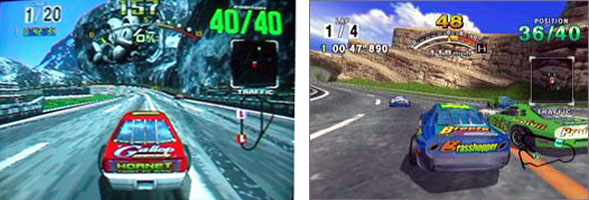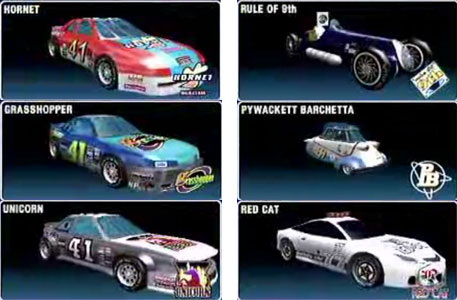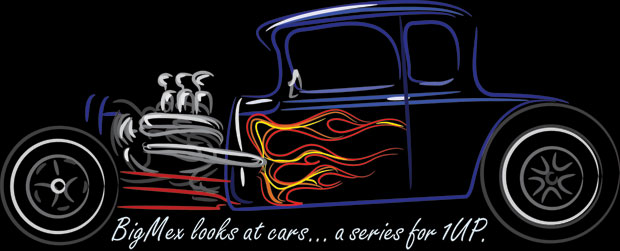The Daytona USA series is an odd duck among racers. It, like Super GT and the other Sega classics, is either loved or loathed by racing fans. Feelings about Daytona USA are much stronger than any other racer by Yu Suzuki, or to be more accurate as Alex aka FerrarimanF355 pointed out to me the director for many of the Sega racers including Daytona USA was Toshihiro Nagosh. The reasons for which might come down to what Japan doesn't understand about Western racing culture. Those that dislike Daytona USA would argue that the title was unabashedly Japanese in scope, it succeeds by being an ignorant arcade statement about stock cars and western racing. Those critics might be right.

The track for which the game is named is based on the legendary Daytona International track in Florida. It was among the oldest of tracks in a fledgling NASCAR circuit. Back in the 50's the track was right on the beach. Massive production cars would tear up the sand, just a few feet from brave, or crazy spectators. These cars were stock in appearance but everything under the sheet metal was anything but. Even today the stock cars carry the large proportions granted by their originators. The current Daytona track is built right over that original track in the sand. It is as beloved a racing course as any other track in the world. Only a few things in Daytona USA would even draw comparisons to the real deal.
The original beginner track in Daytona USA was a three turn oval but it looked nothing like the real course. It was far more fantastic in origin. Snow capped mountains loomed in the background and a rocky cliff was etched with the visage of Sonic the Hedgehog. This track, like every track AM2 was famous for, excelled in the spectacle. The layout defied logic but was an amazing sight to behold. Virtual architecture that rivaled the greatest wonders of the world. Courses that snaked through a canyon, inches from NYC skyscrapers or rumbled down the middle of an amusement park. These were the best tracks I had ever experienced but at the same time the name of the game and style of car had rubbed me the wrong way.

I grew up on racing. Being a fan of every type of circuit and style imaginable. You can guess that my feelings toward a Sega game named Daytona would be mixed. The game featured the familiar boxy cars from the NASCAR circuit but they looked a little odd. This was not a licensed stock car racer so the cars had to give a familiar vibe by their shape and bright paint job. However these things were done from a Japanese perspective. Japan had more experience with GT and even F-1 racing. Those were cars that were created with racing in mind, rather than regular cars turned into racers by mechanics. The Japanese interpretation of the stock car was, for lack of a better word, dubious. The stock car was a foreign breed, a big and brutish American racer. It was unrefined and garish, much too swollen for racing, brightly painted in contrasting colors, a rolling reflection of the loud gaijin and beer swilling rednecks that adored driving 500 miles in a circle. The cars featured in Daytona USA reflected this brutal opinion.

The cars were more or less shaped like stock cars but with fanciful names and questionably-designed logos. Undoubtedly fruity names to get Japanese gamers interested in these brutes. The game was made to bring American gamers to the arcade, but to make it more appealing to the rest of the world it made many concessions to the car design and gameplay. The Daytona series played just like the previous Sega racers. The only way to beat the courses was to drift, or power slide, around every corner. Each successive pass would "slingshot" you past opponents. The sight of massive blocky cars sliding around corners, in the way that was previously reserved for lightweight Ferraris, was too much to behold. The secret cars were anything but more stockers, they were instead crazy-named cars that players could unlock for added replay value. These odd cars were a jab at the roster of racing machines featured in Namco's rival Ridge Racer. I was unimpressed with the effort and slightly disappointed with how Japan was treating the stock car name.
The game was beautiful and is still fun to play, if you could get past the suspension of disbelief. Daytona USA 2 looked amazing on an updated version of the Model 3 board. It's tracks were among the best ever, even trumping the eye candy featured in Super GT.
Unlike Super GT the consoles and PC saw several versions of the Daytona racer released. The most recent appearance of Daytona USA also happens to be the most memorable. The great Daytona USA 2 tracks make an appearance as a single interconnected track in OutRun 2's bonus stage. Making it a definite must-get for racing game fans. Did you know that the things that got NASCAR purists riled up with Daytona USA worked in a different breed of racer? Sega's obsession with drifting would finally make an appropriate appearance, but not in a Yu Suzuki game. Find out which game I'm talking about tomorrow!


No comments:
Post a Comment